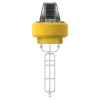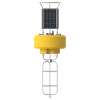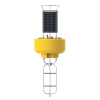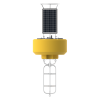Sea-Bird Scientific HydroCAT CTD
Features
- Anti-foulant device and pumped internal flow path for maximum bio-fouling protection
- High initial accuracy with factory-calibration and low drift rate
- Common deployment duration of three plus months, reducing field costs
- Expedited repair and warranty service
- Lifetime technical support
- More
Overview
The Sea-Bird Scientific HydroCAT CTD is ideally suited for extended deployments in remote, biologically rich environments. Field-proven sensors measure and record conductivity, temperature, pressure and optical dissolved oxygen, ensuring long-term data stability. Depending on the application, the HydroCAT can collect high-quality data for several months up to a year.
Stable and Durable
Excellent bio-fouling protection is provided by EPA-approved anti-foulant devices, an integral pump, and a unique internal flow path, which minimizes flow between samples and provides stable measurements throughout a deployment.
Field-Proven
The aged and pressure–protected thermistor has a long history of exceptional stability and accuracy. The oxygen sensor was designed by SBE to meet the demand for a low maintenance and high accuracy sensor for use in applications such as hypoxia monitoring. All HydroCAT sensors are built with careful choices of materials and geometry combined with superior electronics and calibration methodology to optimize field performance.
In The News
Sustainable Data Collection: Climate Monitoring in the Caribbean
Environmental monitoring in the Caribbean may be essential, but it has also historically been placed on the back burner. Albert Jones, Instrumentation Officer for the Caribbean Community Climate Change Centre (CCCCC), explains, “Data collection itself is not what is considered one of those sexy activities where you can easily get funding.” Still, monitoring the water surrounding island nations is necessary to protect residents and the environment. The CCCCC works to establish environmental monitoring networks and systems in the Caribbean. One aspect of Jones’ work centers around data buoy instrumentation and deployment,—equipment that will be used to support Ecoforecasts for Coral Health Monitoring and to provide valuable environmental data to the public.
Read MoreProtecting the Caloosahatchee Estuary: Marine Water Quality Systems in Southwest Florida
The southwest Coast of Florida is home to an incredible array of natural wonders, from the Florida Everglades to the Pine Island Sound Aquatic Preserve and the many miles of coastline in between. Yet there is also a high density of urbanization in this region, stretching from Fort Myers to Cape Coral and down to Marco Island, with an estimated population of 1.4 million, much within coastal watersheds, according to the Lee County Economic Development Office . Many inland rivers that run through this area of the state drain into the Gulf of Mexico. One of these is the Caloosahatchee River, which forms an estuary just past Cape Coral out towards Pine and Sanibel Islands.
Read MoreSpring 2025 Environmental Monitor Available Now
In the Spring 2025 edition of the Environmental Monitor, we highlight partnerships across the world and the importance of collaboration between government agencies, universities, environmental groups, local communities, and other stakeholders. From great white shark research in Cape Cod to monitoring fisheries in Lake Erie, this latest edition underscores partnerships that connect stakeholders in a watershed through environmental data. With an emphasis on data sharing, a combination of real-time and discrete sampling keeps the public and partners informed of environmental conditions. Our writers also sought out science professionals dedicated to working with peers within and outside of the environmental sector.
Read More























